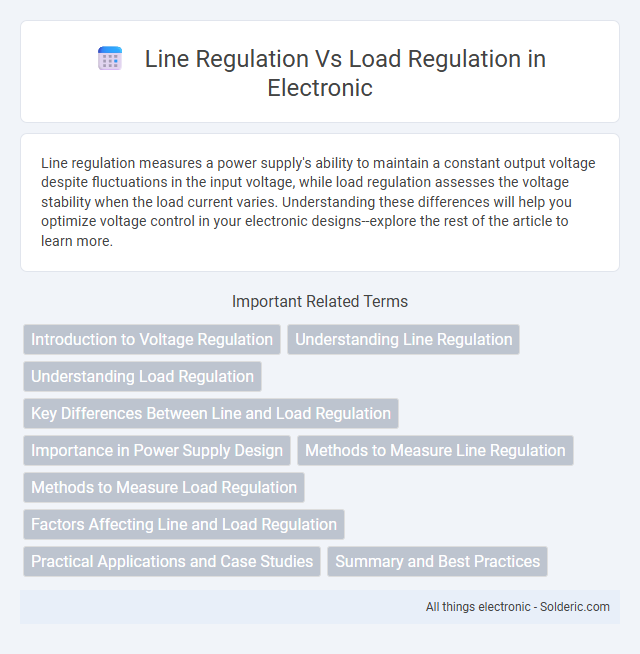Line regulation measures a power supply's ability to maintain a constant output voltage despite fluctuations in the input voltage, while load regulation assesses the voltage stability when the load current varies. Understanding these differences will help you optimize voltage control in your electronic designs--explore the rest of the article to learn more.
Comparison Table
| Aspect | Line Regulation | Load Regulation |
|---|---|---|
| Definition | Measures voltage stability when input voltage varies. | Measures voltage stability when output load varies. |
| Parameter | Input voltage changes (Vin) | Output load changes (Load current) |
| Purpose | Maintain constant output despite input fluctuations. | Maintain constant output despite changes in load demand. |
| Expressed As | (DVout / DVin) x 100% | (DVout / DIload) x 100% |
| Typical Application | Power supplies with varying input voltage. | Regulators with variable load conditions. |
| Significance | Indicates regulator's input voltage sensitivity. | Indicates regulator's load handling capability. |
Introduction to Voltage Regulation
Voltage regulation is critical for maintaining stable output voltage in power supplies despite external fluctuations. Line regulation measures voltage stability when input voltage changes, while load regulation assesses output consistency as the load varies. Effective voltage regulation ensures reliable performance and protects sensitive electronic components from damage.
Understanding Line Regulation
Line regulation measures how well a power supply maintains a constant output voltage when the input voltage varies within its specified range. This parameter is crucial for ensuring stable performance and protecting sensitive electronic components from voltage fluctuations. Understanding line regulation helps you evaluate a power supply's ability to deliver consistent voltage despite changes in supply input conditions.
Understanding Load Regulation
Load regulation measures a power supply's ability to maintain a consistent output voltage as the output current varies due to changes in the connected load. It is typically expressed as a percentage or voltage difference between no-load and full-load conditions. Understanding load regulation is crucial for ensuring Your devices receive stable power, preventing performance issues caused by voltage fluctuations under varying load demands.
Key Differences Between Line and Load Regulation
Line regulation measures a power supply's ability to maintain a constant output voltage despite variations in input voltage, often expressed in percentage or millivolts per volt. Load regulation evaluates the stability of the output voltage as the load current changes, typically quantified by the difference in output voltage between full load and no load. Key differences include their focus parameters--input voltage for line regulation and output load current for load regulation--and their impact on maintaining consistent voltage in varying operating conditions.
Importance in Power Supply Design
Line regulation and load regulation are critical parameters in power supply design because they directly affect the output voltage stability under varying input voltage and load conditions. Effective line regulation ensures minimal voltage variation when the input voltage fluctuates, while good load regulation maintains constant output voltage despite changes in load current. Your power supply's performance and reliability depend on optimizing both to achieve steady and reliable power delivery to electronic components.
Methods to Measure Line Regulation
Line regulation is measured by varying the input voltage to a power supply while keeping the load constant, then observing the change in output voltage, typically expressed as a percentage or millivolts per volt. Common methods include using a variable DC power supply to adjust the input voltage and a precise voltmeter or data acquisition system to record the output voltage changes. Accurate measurement also involves maintaining thermal stability and minimizing noise to ensure the output variations strictly reflect input line voltage fluctuations.
Methods to Measure Load Regulation
Load regulation is measured by varying the load current from minimum to maximum values while keeping the input voltage constant and observing the output voltage deviation. Techniques include using electronic loads or resistive loads to simulate changes, combined with precision voltmeters or digital multimeters to record the output voltage variations accurately. Data from these measurements provide critical insights into the voltage stability of power supplies under different load conditions.
Factors Affecting Line and Load Regulation
Line regulation is primarily affected by variations in input voltage, temperature fluctuations, and the internal resistance of voltage regulators, which influence the stability of the output voltage. Load regulation depends on changes in output current, device saturation levels, and transient response characteristics that determine how well the regulator maintains voltage with varying load conditions. Your ability to optimize power supply performance relies on understanding these factors and selecting components that minimize voltage deviations under both input and load changes.
Practical Applications and Case Studies
Line regulation and load regulation are critical parameters in power supply design, influencing voltage stability under varying input voltage (line regulation) and output current (load regulation) conditions. Practical applications such as precision instrumentation and sensitive electronic devices require tight line and load regulation to ensure consistent performance and prevent operational errors caused by voltage fluctuations. Case studies in industrial automation and medical equipment highlight how superior regulation improves reliability, efficiency, and protection of your circuits in dynamic environments.
Summary and Best Practices
Line regulation measures a power supply's ability to maintain a constant output voltage despite changes in input voltage, while load regulation assesses voltage stability under varying output currents. Maintaining tight control over both line and load regulation is crucial for ensuring reliable performance in sensitive electronic applications. You should prioritize high-quality components and precise feedback control circuits to achieve optimal regulation and system stability.
Line Regulation vs Load Regulation Infographic

 solderic.com
solderic.com